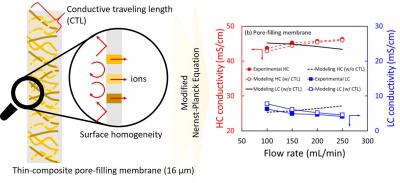Identified ion transfer principle with reverse electrodialysis method which is representative marine

Credit: Korea Institute of Energy Research(KIER)
Dr. Kim Hanki of Jeju Global Research Center, Korea Institute of Energy Research (Director Kwak Byong-Sung) developed a mathematical analysis model that can identify the ion transfer principle of salinity gradient power technology. The result was published in ‘Water Research,’ which is the top authority in the field of water resources.*
* Water Research: Number 1 international journal in the field of water resources (published by Elsevier, SCI IF 7.051)
Salinity gradient power produces electrical energy by using the difference in salt concentration between seawater and fresh water which has a tremendous energy potential. Now, the technology development for commercialization is actively progressing.
The reverse electrodialysis is a representative salinity gradient power technology. It converts free energy in seawater to electrical energy by moving ions through ion-exchange membranes. Recently, key technologies such as pore-filled ion-exchange membranes ** have been newly developed. However, it is tough to analyze the performance of the pore-filling ion-exchange membranes with existing mathematical model precisely.
** Pore-filling ion exchange membrane: A separator membrane which is made to selectively ion exchange by filling a hydrophilic polymer capable of ion transfer in nano size pores of hydrophobic support. It has lower electrical resistance and higher selectivity than commercial ion exchange membranes
To solve this issue, the researchers successfully applied the concept of ‘Conductive Traveling Length (CTL)’ into the existing mathematical model to identify the principle of ion transfer in the pore-filling ion-exchange membranes.
‘Conductive Traveling Length’ is the movement distance of ions through the hydrophilic nano pores in the pore-filling ion exchange membrane. By calculating the ratio of conductive site in nano pores in the ion exchange membrane, it became possible to develop the results of ion transfer analysis and the accuracy of predicting the performance of reverse electrodialysis.
In addition, the developed mathematical model by the research team can be applied to various ion-exchange membranes including pore-filling ion-exchange membrane. This method will significantly impact the commercialization of reverse electrodialysis technology.
Kim Hanki, a senior researcher at the Korea Institute of Energy Research, who is the main author of the research paper said, “Through this development of analytical modeling, the increase in feasibility of the design and performance of reverse electrodialysis is expected, which can accelerate its development. Moreover, the developed mathematical modeling will contribute to localization of manufacturing ion-exchange membrane and the reverse electrodialysis stack.”
Meanwhile, Jeju Global Research Center of Korea Institute of Energy Research has completed localization of the pore-filled ion exchange membrane then succeeded in development of the reverse electrodialysis equipment. The researchers are now leading the field in salinity gradient power by conducting the projected named ‘Developing core-technology of salinity gradient power for building electrical vehicle (EV) charging infrastructure.’
###
Media Contact
Woo Eugene
[email protected]
82-428-603-361
Related Journal Article
http://dx.




